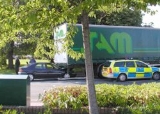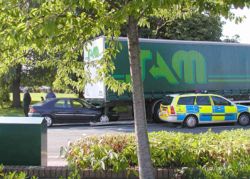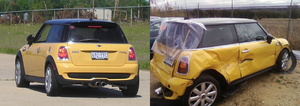
Rear-end collision
Encyclopedia

Vehicle
A vehicle is a device that is designed or used to transport people or cargo. Most often vehicles are manufactured, such as bicycles, cars, motorcycles, trains, ships, boats, and aircraft....
(usually an automobile
Automobile
An automobile, autocar, motor car or car is a wheeled motor vehicle used for transporting passengers, which also carries its own engine or motor...
or a truck
Truck
A truck or lorry is a motor vehicle designed to transport cargo. Trucks vary greatly in size, power, and configuration, with the smallest being mechanically similar to an automobile...
) crashes into the vehicle in front of it, usually caused by tailgating
Tailgating
Tailgating is the practice of driving on a road too close to the vehicle in front, at a distance which does not guarantee that stopping to avoid collision is possible...
or panic stops. It may also be a rail accident
Classification of railway accidents
Classification of railway accidents, both in terms of cause and effect, is a valuable aid in studying rail accidents to help to prevent similar ones occurring in future...
wherein a train
Train
A train is a connected series of vehicles for rail transport that move along a track to transport cargo or passengers from one place to another place. The track usually consists of two rails, but might also be a monorail or maglev guideway.Propulsion for the train is provided by a separate...
runs into the rear of a preceding train.
Typical scenarios for rear-ends are a sudden deceleration by the first car (for example, to avoid someone crossing the street) so that the following car does not have the time to brake and collides with the first. Alternatively the following car may accelerate more rapidly than the leading (for example, leaving an intersection) resulting in an equivalent collision.
As a rule of thumb, if the two vehicles have similar physical structure, crashing into another car is equivalent to crashing into a rigid surface (like a wall) at half of the closing speed. This means that rear-ending a stationary car while travelling at 30 mph is equivalent, in terms of deceleration, to crashing into a wall at 15 mph. The same is true for the vehicle crashed into. However if one of the vehicles is significantly more rigid (e.g. the rear of a truck) then the deceleration is more typically reflected by the full closing speed for the less rigid vehicle.
A typical medical consequence of rear-ends, even in case of collisions at moderate speed, is whiplash
Whiplash (medicine)
Whiplash is a non-medical term describing a range of injuries to the neck caused by or related to a sudden distortion of the neck associated with extension. The term "whiplash" is a colloquialism...
. In more severe cases permanent injuries, e.g. herniation
Spinal disc herniation
A spinal disc herniation , informally and misleadingly called a "slipped disc", is a medical condition affecting the spine due to trauma, lifting injuries, or idiopathic, in which a tear in the outer, fibrous ring of an intervertebral disc allows the soft, central portion A spinal disc herniation...
, may occur. The rearmost passengers in minivans benefit little from the short rear crumple zone
Crumple zone
The crumple zone is a structural feature mainly of automobiles. Crumple zones have also been incorporated into railcars in recent years.They are designed to absorb the energy from the impact during an accident by controlled deformation. This energy is much higher than is commonly recognized...
, so they are more likely to be injured or killed in a rear-end collision.
For purposes of insurance
Insurance
In law and economics, insurance is a form of risk management primarily used to hedge against the risk of a contingent, uncertain loss. Insurance is defined as the equitable transfer of the risk of a loss, from one entity to another, in exchange for payment. An insurer is a company selling the...
and policing, the driver of the car that rear-ends the other car is almost always considered to be at fault due to not being within stopping distance or lack of attention. An exception to this rule comes into play if the rear-ended vehicle is in reverse
Transmission (mechanics)
A machine consists of a power source and a power transmission system, which provides controlled application of the power. Merriam-Webster defines transmission as: an assembly of parts including the speed-changing gears and the propeller shaft by which the power is transmitted from an engine to a...
gear. If the driver of the car that was rear-ended files a claim against the driver who hit him, said driver could be responsible for all damages
Damages
In law, damages is an award, typically of money, to be paid to a person as compensation for loss or injury; grammatically, it is a singular noun, not plural.- Compensatory damages :...
to the other driver's car.
The Ford Pinto
Ford Pinto
The Ford Pinto is a subcompact car produced by the Ford Motor Company for the model years 1971–1980. The car's name derives from the Pinto horse. Initially offered as a two-door sedan, Ford offered "Runabout" hatchback and wagon models the following year, competing in the U.S. market with the AMC...
became the focus of widespread concern when it was alleged that a flaw in its design could cause fuel-fed fires as the result of a rear-end collision.
See also

- Road accident typesRoad accident typesRoad traffic accidents generally fall into one of four common types:* Lane departure crashes, which occur when a driver leaves the lane they are in and collide with another vehicle or a roadside object...
- TailgatingTailgatingTailgating is the practice of driving on a road too close to the vehicle in front, at a distance which does not guarantee that stopping to avoid collision is possible...

